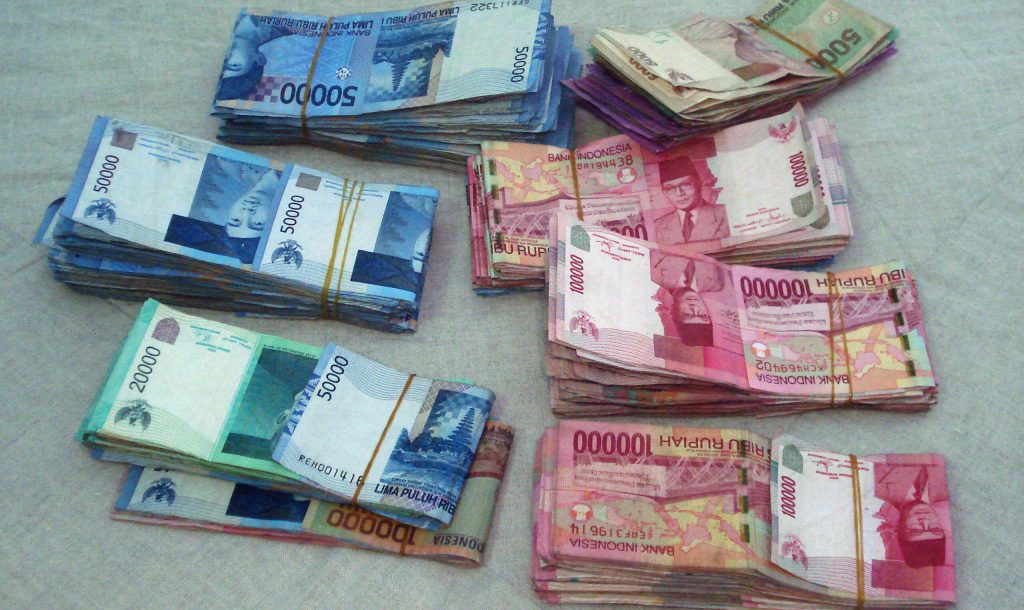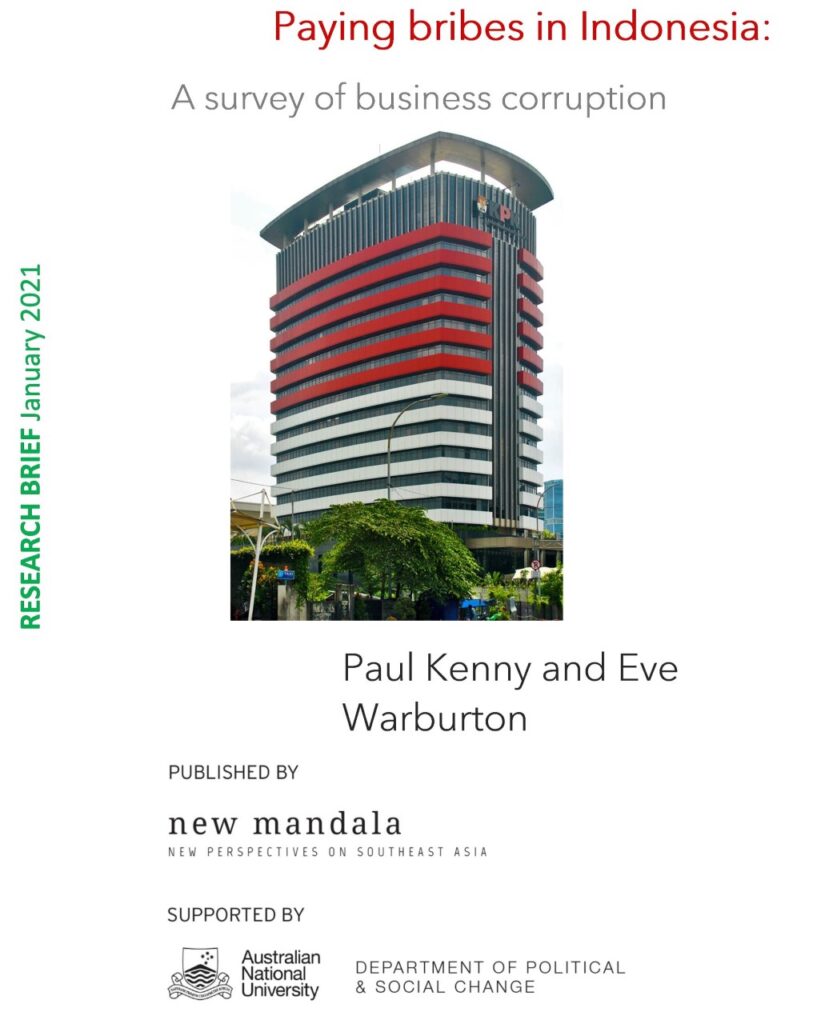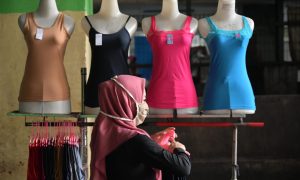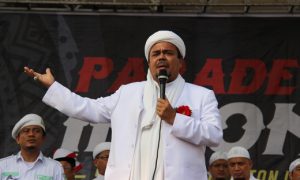Corruption is a pervasive feature of Indonesia’s contemporary political economy. In-depth studies and cross-national surveys alike emphasise that illicit fees and bribery are widespread across the public and private sectors, and in the everyday lives of Indonesians. Transparency International’s Corruption Perceptions Index, which is based on the views of experts and business people, gave Indonesia a score of 40 out of a possible 100 in 2019, where 100 is very clean. This moved Indonesia up to the 85th position in the world in 2019, an improvement on recent years—in 2014 Indonesia was ranked 107th.
On other sorts of measures, however, it’s clear that corruption remains an ongoing impediment to governance and investment. In the 2017 World Economic Forum’s Executive Opinion Survey, for example, companies reported corruption to be the most significant challenge for their operations in Indonesia. Yet in the World Bank’s 2015 Enterprise survey (which draws on a larger sample but with a more limited sectoral reach) just 13% of business people stated that corruption was a major constraint on their firm’s operations. Such wide-ranging assessments underscore the challenge of measuring corruption, but also suggest that companies in Indonesia experience corrupt exchanges in very different ways.
Our new report Paying Bribes in Indonesia contributes to efforts to better understand the nature of corruption in contemporary Indonesia. It looks specifically at how businesses experience bribery and extortion, and how those experiences differ depending on the sector, firm type, and on the different actors with whom firms interact. To do so, we conducted a survey of Indonesian business elites.
Sectors matter
In collaboration with the Indonesian Survey Institute (Lembaga Survei Indonesia, LSI), we administered a face-to-face survey of 672 business representatives between July 2019 and February 2020. The sample frame was designed to reflect the structure of the Indonesian economy in terms of sectoral contributions, the geographic spread of economic activity, and the size of the firms operating in each sector. We offer a brief glimpse at the findings here, but further detail, analysis and discussion of anti-corruption reforms, can be found in our full report.
We first examined firms’ experience of corruption, and their perception of the prevalence of corruption in their sector. We asked respondents (1) how frequently their firm has been asked to pay illicit fees or bribes (2) how frequently they have paid illicit fees or bribes and (3) how common it is for firms in their sector to pay illicit fees or bribes. Overall, some 33.2% of firms report that they have been asked to pay fees outside the official requirements (i.e. extortion, facilitation, or security money). 30.6% report having paid such fees, while 35.7% believe such illicit fees are commonly paid by businesses in their sector. These figures are marginally higher than results reported in the World Bank’s Enterprise Survey from 2015, where 30% of Indonesian firms (in the manufacturing, service and retail sectors) stated they had experienced at least one bribe payment request.
But responses vary significantly by industry. The highest proportions of firms reporting being extorted, paying bribes and believing the practice is common in their sector (columns 1 to 3) are found in the extractive industries (47.9, 42.7, 53.1%) and in construction (49.5, 44.2 and 51.6%), while the lowest proportion of firms is in the financial sector (17.0, 16.0 and 22.3%). It is worth noting that in most cases (trade and logistics being the exceptions), the perceived incidence of corruption is higher than the reported experience of corruption.
We also asked respondents whether firms in their sector ever manipulate financial reports (column 5). Very few companies responded that such practices were commonplace (9.8% overall, with a non-response rate of 4.0%). Again, however, variation across sectors is revealing. Responses ranged from highs of 16.8% in the construction sector and 15.6% in the extractive sector, to a low of 2.1% in the financial sector.
Explaining sectoral differences—hiding profits
These sectoral differences reflect, in many ways, global patterns of corruption. Mining and other resource extraction industries, especially in middle-income and developing countries, are particularly vulnerable to corrupt practices on the part of firms, politicians and bureaucrats. Analysts have long argued that natural monopolies, such as in petroleum oil extraction or timber logging, provide opportunities for rent extraction for government agents. Additionally, all around the world, from developed to developing countries, construction sectors are notoriously corrupt and present state officials with opportunities for kickbacks and bribes.
In Indonesia, previous research has shown that construction and public infrastructure is especially prone to corruption. The state issues crucial licenses and plays a substantial regulatory role in these sectors, making them more prone to rent-seeking on the part of state officials as well. Firms also benefit directly from engaging in corruption (access to licenses and permits, for example) and thus have strong incentives to invest in corrupt exchanges, especially in developing countries where autonomous judicial oversight is weak.
What our survey suggests, however, is that extractives and construction share another feature that has so far been overlooked in studies of corruption. The fact that firms in these two sectors are much more likely to alter their financial reports indicates that, potentially, hiding firm profits is easier and more common.
Both the construction sector and natural resource industries are characterised by bespoke (as opposed to standardised), uncertain inputs and outputs. This in turns make manipulating reports and hiding revenue from auditors much more viable. Firms in these sectors can thus ‘make back’ the losses incurred through bribery and extortion. For example, each infrastructure project, and each mineral, oil or coal deposit is different, such that estimating and monitoring the real costs of constructing a mine in a given location is immensely difficult, making this phase of an extractive project ripe for financial manipulation. Output—the amount of coal or oil being extracted—is also highly variable. Unreported production can thus be diverted onto the black market beyond the purview of tax collectors.
Designing solutions at the sector level
What do these findings mean for measuring corruption generally and for anti-corruption policy in contemporary Indonesia specifically? Measuring corruption at the national scale, and making cross-country comparisons based on those state-level observations, might produce misleading characterisations of the nature of corruption in a country such as Indonesia. Transparency International’s Corruption Perceptions Index and the Global Corruption Index by Global Risk Profile, for example, allocate states an overall score when it comes to the intensity of illicit economic activity. The important differences between sectors are usually lost in these aggregated indexes; yet such differences are potentially critical for designing appropriate anti-corruption interventions that focus on both bureaucrats and companies.
Our results suggest a need for more investment in sector-level monitoring agencies and watchdogs. In general, the Jokowi government has pivoted away from punitive measures in the fight against corruption, and instead emphasised preventative measures such as cutting red tape and improving permitting processes. Such interventions have probably reduced firms’ exposure to bribery and rent-seeking.
But the government’s approach has also drawn much criticism. A new law introduced in late 2019 reduces the investigatory powers of the KPK (Corruption Eradication Commission) and undermines the body’s independence by bringing it under the auspices of a politically appointed supervisory body. The move triggered nation-wide protests against what many saw as an attempt to dismantle one of the few effective and trusted corruption watchdogs in the country. This strategy, Jokowi hopes, will relieve investors and firms from the burden of bribery, while avoiding what he views as politically disruptive investigations.
Our data, on the other hand, suggest a need for more, not less, monitoring and enforcement of firms and bureaucrats. Indonesia’s anti-corruption interventions should be designed at the sector level, led by an independent KPK with a strong sectoral orientation, and should engage with the major business actors in each sector.
 Facebook
Facebook  Twitter
Twitter  Soundcloud
Soundcloud  Youtube
Youtube  Rss
Rss 



